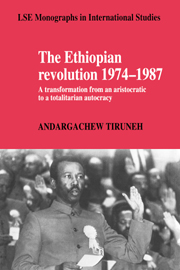 The Ethiopian Revolution 1974–1987
The Ethiopian Revolution 1974–1987 Book contents
- Frontmatter
- Contents
- List of maps and tables
- Acknowledgements
- List of abbreviations
- Map 1 The Horn of Africa
- Map 2 Administrative divisions
- 1 The background to the emergence of the structural crisis
- PART I THE COLLAPSE OF THE OLD-STATE (JANUARY–NOVEMBER 1974)
- PART II THE FORMATIVE YEARS OF THE POST-REVOLUTIONARY ORDER (DECEMBER 1974–FEBRUARY 1977)
- PART III CONSOLIDATION OF POWER (FEBRUARY 1977–SEPTEMBER 1987)
- 8 The elimination of internal and external threats to Mengistu's power
- 9 The formation of the Workers' Party of Ethiopia
- 10 The formalization of power through the 1987 constitution: ‘organizational operation’ in action
- 11 Conclusion
- Postscript
- Appendix: chronology of events
- Notes
- Bibliography
- Index
- LSE MONOGRAPHS IN INTERNATIONAL STUDIES
11 - Conclusion
Published online by Cambridge University Press: 18 December 2009
- Frontmatter
- Contents
- List of maps and tables
- Acknowledgements
- List of abbreviations
- Map 1 The Horn of Africa
- Map 2 Administrative divisions
- 1 The background to the emergence of the structural crisis
- PART I THE COLLAPSE OF THE OLD-STATE (JANUARY–NOVEMBER 1974)
- PART II THE FORMATIVE YEARS OF THE POST-REVOLUTIONARY ORDER (DECEMBER 1974–FEBRUARY 1977)
- PART III CONSOLIDATION OF POWER (FEBRUARY 1977–SEPTEMBER 1987)
- 8 The elimination of internal and external threats to Mengistu's power
- 9 The formation of the Workers' Party of Ethiopia
- 10 The formalization of power through the 1987 constitution: ‘organizational operation’ in action
- 11 Conclusion
- Postscript
- Appendix: chronology of events
- Notes
- Bibliography
- Index
- LSE MONOGRAPHS IN INTERNATIONAL STUDIES
Summary
This chapter is primarily concerned with examining the causes and outcomes of the revolution from the perspective of contemporary social science research. It begins with a section which summarizes the main findings of the previous chapters. The summary is followed by other sections intended to develop aspects of the causes and outcomes considered to be controversial and important in explaining the revolution.
SUMMARY OF THE TRANSFORMATIONS
The collapse of the old-state was brought about by structural crisis induced by the centralization, modernization and territorial consolidation drive of the monarchy and by the post-war changes on the international scene. Centralization gave rise to the emergence of a highly centralized autocracy which made itself increasingly irrelevant to a democratizing society; modernization to a new elite which became increasingly vocal in its opposition to the obsolete monarchy; and territorial consolidation to a more diversified population which became more and more difficult to govern. The international dynamic further weakened the state by providing alternative political models to the new elite, weapons and diplomatic support to regionalist insurgents and by imposing economic relations inimical to development. While structural crisis is believed to have played the crucial role in weakening the old-state, it is, perhaps, complementary. Structural crisis can be seen as having prepared the ground for the 1974 action of the revolutionary social groups. The harassment of the old-state through strikes, demonstrations and petitions co-ordinated by the steering committees that sprang up in the corporate groups in the course of the uprising of 1974 cannot be fully explained without resort to conscious action on the part of the partisans.
- Type
- Chapter
- Information
- The Ethiopian Revolution 1974–1987A Transformation from an Aristocratic to a Totalitarian Autocracy, pp. 299 - 343Publisher: Cambridge University PressPrint publication year: 1993


